ITALY IN THE FALL OF 2004
Italy again - the third time in a year
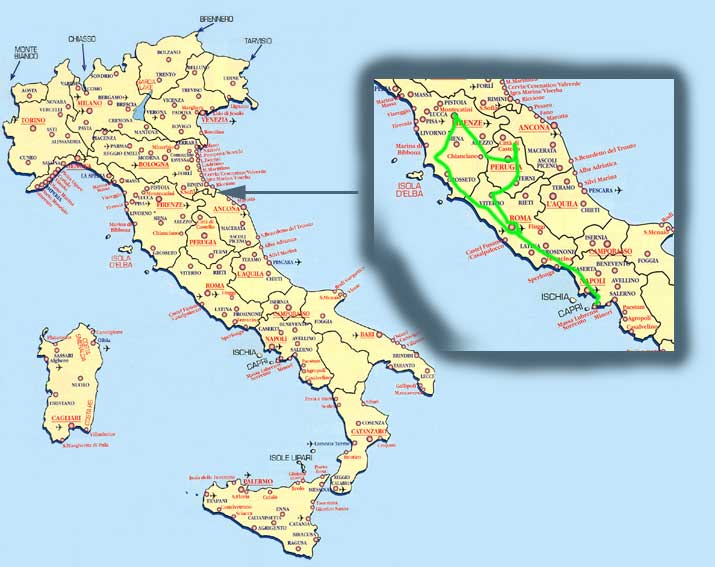
This trip, in October of 2004, was inspired
primarily by a strong urge to get back to Gubbio. On our previous trip (in May, 2004) we had
arrived there with sufficient time to get only a taste of this town – a taste that left
us wanting more. The card George gave me on my birthday a couple of weeks after we arrived back
home had on it one of the photos he had taken there and the caption: “Next year Gubbio
but for now…Happy Birthday;” but, less than four months later (and in that same
year) we were returning – and we were filled with high expectations.
We flew on a ZOOM charter flight directly from Vancouver into Stansted and made a four hour
connection on RYAN Air into Ciampino Airport (Rome). It was late afternoon on a Sunday when
we arrived, picked up our rental car from Italy by Car, drove the circle road around Rome (not
as easy as it sounds) and headed north in the direction of Gubbio.
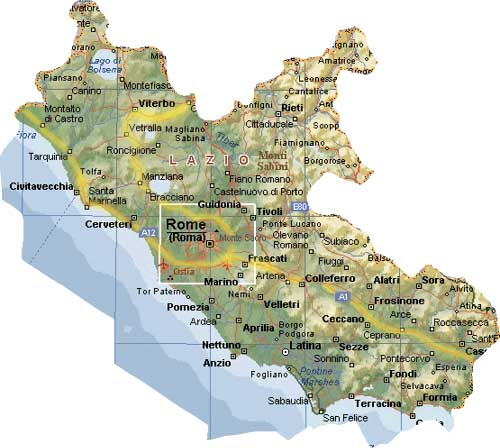
We stopped that evening in Viterbo – a destination chosen because it was a short drive and seemed reachable by dark. (By the time we had picked up the car, we had been travelling about 24 hours; so, a short drive made sense). We had booked a hotel (Hotel Roma) recommended in our Lonely Planet and were settled in before restaurants opened to serve the evening meal. We were starving and were the first customers to enter what turned out to be a fabulous restaurant – undoubtedly one of the best pizzas (a gorgonzola one) that we have ever tasted. While enjoying this and the wine, we began to relax and to feel less tired. We walked a bit more and, in the morning, got up very early to stroll around the city before it had awakened. Viterbo is described as Lazio’s best-preserved medieval city and, though badly bombed during World War II, had the look of a pleasant, lively place. We would have stayed longer had we not been headed for Gubbio.
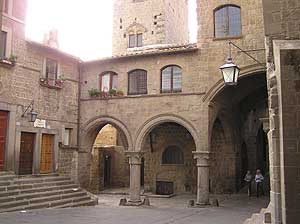
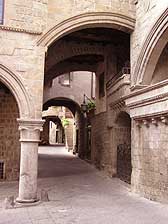
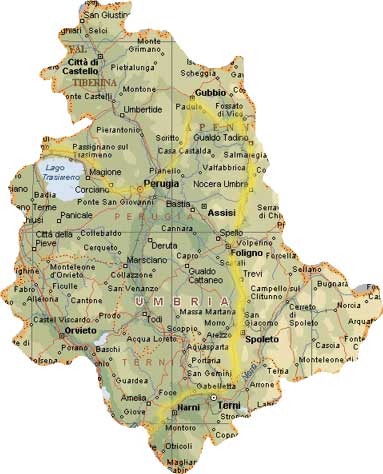
We stopped at Spoleto,
described as a sleepy, 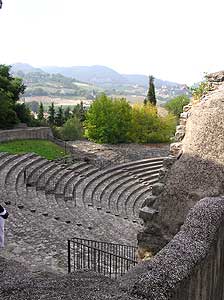 enchanting
town that is one of Umbria’s main centres for black truffles, to see some of the sites.
The most famous is the 1st century roman theatre
enchanting
town that is one of Umbria’s main centres for black truffles, to see some of the sites.
The most famous is the 1st century roman theatre  that
is currently used for performances each June/July when the town hosts an international parade
of drama, music, opera, and dance. Dominating the town is the Rocca Albornoziana, a former papal
fortress that until 1982 was a high-security prison housing such notables as Pope John Paul
II’s attempted assassin, Ali Agca.
that
is currently used for performances each June/July when the town hosts an international parade
of drama, music, opera, and dance. Dominating the town is the Rocca Albornoziana, a former papal
fortress that until 1982 was a high-security prison housing such notables as Pope John Paul
II’s attempted assassin, Ali Agca.
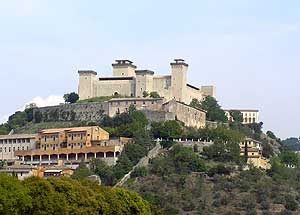
From there we headed straight north
to Gubbio, arriving in the late afternoon to settle into Grotta dell’
Angelo (Via Gioia, 47 – 06024; (075) 9293438-9271747), a 2-storey, grey stone hotel
on an ancient side street that was charming, clean and remarkably inexpensive. We had  checked
it out on our last trip when we had been staying at Hotel San Marco, a large converted
monastery with all the modern hotel conveniences which we had enjoyed but deemed too expensive
for this – a
checked
it out on our last trip when we had been staying at Hotel San Marco, a large converted
monastery with all the modern hotel conveniences which we had enjoyed but deemed too expensive
for this – a 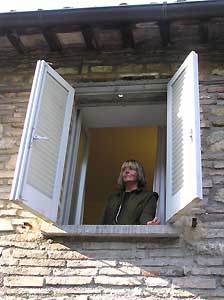 longer
stay. On that earlier trip it had rained very heavily and, on several occasions we got drenched
(once in a hail storm); so, we had appreciated those modern hotel conveniences. This time, however,
the sun was shining.
longer
stay. On that earlier trip it had rained very heavily and, on several occasions we got drenched
(once in a hail storm); so, we had appreciated those modern hotel conveniences. This time, however,
the sun was shining.
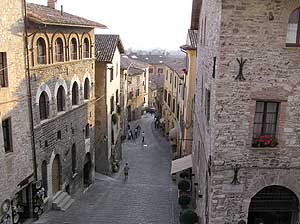
Gubbio, being at the centre of truffle-producing
land, 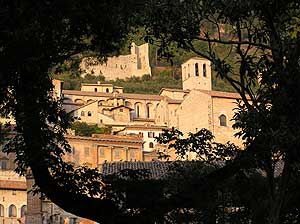 has
a mushroom festival in September but this was October 4th and the town was back to being the
quiet (virtually tourist-free) spot we remembered and wanted. That evening we found our way
to a restaurant (Fabiani) on the centre square, known from the previous visit, had a
leisurely meal (served by the same waitress who had surprised us in May by her command of English
- she had moved to Gubbio from the Balkans after meeting and falling in love with a local fellow)
and took the slow route back to our hotel.
has
a mushroom festival in September but this was October 4th and the town was back to being the
quiet (virtually tourist-free) spot we remembered and wanted. That evening we found our way
to a restaurant (Fabiani) on the centre square, known from the previous visit, had a
leisurely meal (served by the same waitress who had surprised us in May by her command of English
- she had moved to Gubbio from the Balkans after meeting and falling in love with a local fellow)
and took the slow route back to our hotel.
The cobblestone streets being pretty much deserted gave the sense that many centuries had been
peeled away, taking us back to distant times. Gubbio’s city walls, still well-preserved,
were built at the end of the 13th century for defensive purposes. Now they seem to wall in the
history, defending the town primarily against tarnish of modern times. One can walk around the
whole town never losing site of them.
 Gubbio
remains the home of Ubaldo Baldassini, born there in 1085, who became its Bishop in 1128, died
there in 1160, and was declared the town’s patron saint less than 30 years later. His
body, although not embalmed, has remained intact, and lies in the Basilica of Sant’Ubaldo
perched high above the city on Monte Ingino. At night a light shines to pinpoint the spot, serving
as a constant reminder of his presence. In the daytime, one can ascend via a curious birdcage
funicular up the steep slope and walk from where it lands upward to the Basilica to view his
body lying in a glass coffin above the altar.
Gubbio
remains the home of Ubaldo Baldassini, born there in 1085, who became its Bishop in 1128, died
there in 1160, and was declared the town’s patron saint less than 30 years later. His
body, although not embalmed, has remained intact, and lies in the Basilica of Sant’Ubaldo
perched high above the city on Monte Ingino. At night a light shines to pinpoint the spot, serving
as a constant reminder of his presence. In the daytime, one can ascend via a curious birdcage
funicular up the steep slope and walk from where it lands upward to the Basilica to view his
body lying in a glass coffin above the altar.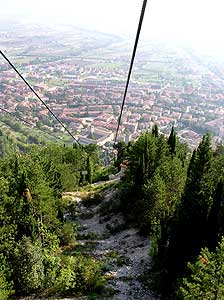 On our previous trip the funicular was closed due to high winds; this time it was operating;
so, we ascended a couple of times partly for the fabulous view but primarily for the unusual,
genuinely spiritual, experience that awaits.
On our previous trip the funicular was closed due to high winds; this time it was operating;
so, we ascended a couple of times partly for the fabulous view but primarily for the unusual,
genuinely spiritual, experience that awaits.
The setting is serene and alive with greenery; the walk to the Basilica, up stone stairs, across a shadowy, grey courtyard, to the exterior of 13th century church that is, aside from the massive door, devoid of ornament, inspires awe. So, in silence, we walked in, and finding ourselves alone in the building, looked up at Ubaldo, lying above the neo-Gothic high altar. And we viewed, as well, the three huge (22 foot tall wooden) ‘candles’ that are carried down the mountain each year on the first Sunday in May by three teams dressed in similar costume but of different colour - yellow (representing St. Ubaldo), pale blue (representing St. George) and black (representing St. Anthony). This ‘Race of the Ceri’ involves the entire population in a religious festival that culminates on May 15 (the anniversary of St. Ubaldo’s death) with the return of the ‘candles’ to the Basilica.
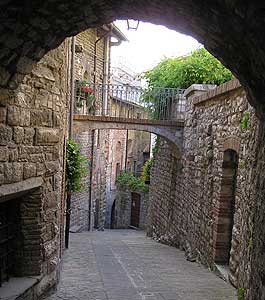 Aside
from our trips up to the Basilica, we strolled the town, touring churches, and remaining enchanted
by the palpable sense of history. We ate at only two restaurants, returning to them because
we enjoyed them so much and, although we had some nostalgic allegiance to Fabiani (familiar
from our first trip,) it was Bosone Garden Ristorante that we chose for our last dinner
in the town. Its little outdoor rooftop patio (part of a hotel made of 15th century stone) was
irresistible; it was almost deserted; the food was fabulous.
Aside
from our trips up to the Basilica, we strolled the town, touring churches, and remaining enchanted
by the palpable sense of history. We ate at only two restaurants, returning to them because
we enjoyed them so much and, although we had some nostalgic allegiance to Fabiani (familiar
from our first trip,) it was Bosone Garden Ristorante that we chose for our last dinner
in the town. Its little outdoor rooftop patio (part of a hotel made of 15th century stone) was
irresistible; it was almost deserted; the food was fabulous.
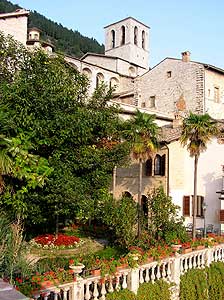
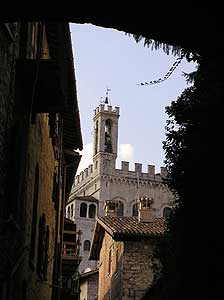
Gubbio is a town we want to return to
again – spring or fall would be ideal though the idea of being there on Easter weekend
is also appealing. On Good Friday there is a procession of the Dead Christ that passes through
the ancient streets of the city.
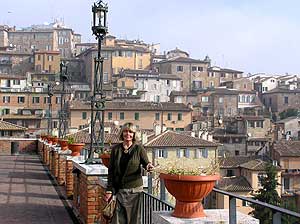 It is also a town we didn’t want to leave; there is something about Gubbio… but
we drove on to Perugia and that turned out to be, while decidedly more in tune
with the modern world, a charming place. We checked into a hotel at the centre of the old town
and found Perugia, with its open air restaurants, much to our liking. We ate lunch and dinner
at the same excellent spot – Ferrari Ristorante Pizzeria and wandered the town
that day and for part of the following morning.
It is also a town we didn’t want to leave; there is something about Gubbio… but
we drove on to Perugia and that turned out to be, while decidedly more in tune
with the modern world, a charming place. We checked into a hotel at the centre of the old town
and found Perugia, with its open air restaurants, much to our liking. We ate lunch and dinner
at the same excellent spot – Ferrari Ristorante Pizzeria and wandered the town
that day and for part of the following morning.
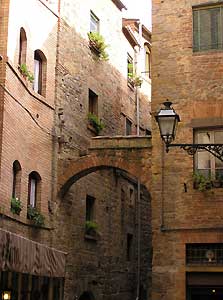

Then, we left for Florence agreeing that this trip we really ‘should’ visit Florence.
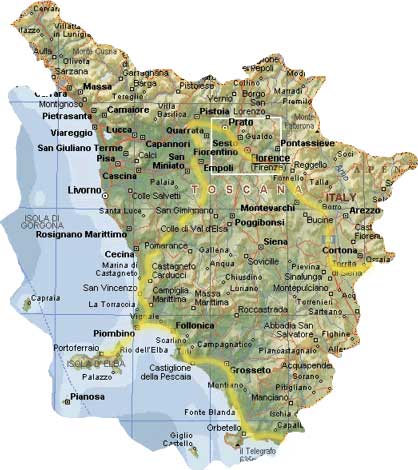
We were hesitant because it’s
a big city and a tourist destination and we were not sure how we’d cope. With a car it
was far too expensive to stay in the city and far too difficult even to figure how to navigate
in; so we booked into a hotel (Albergo Il Giglio) in the old part of Prato
(one of Italy’s main textile centres and an industrial city of about 200,000 that feels
like a suburb of Florence) that was reasonably inexpensive, had a parking spot at the door and was a short walk to the
train that would take us in 30 minutes into the centre of Florence. We took the train into Florence
and, after six hours we left - never to return. We had actually wanted to depart within an hour
of our arrival but felt that we should at least walk around and have dinner in the big city.
Over dinner, we confessed to each other that we were miserable; the scaffolding got to us, the
herds of tourists stifled us; the phoney Gucci bags on every street corner annoyed us; the restaurant
we ate in was too expensive and not at all memorable.
that was reasonably inexpensive, had a parking spot at the door and was a short walk to the
train that would take us in 30 minutes into the centre of Florence. We took the train into Florence
and, after six hours we left - never to return. We had actually wanted to depart within an hour
of our arrival but felt that we should at least walk around and have dinner in the big city.
Over dinner, we confessed to each other that we were miserable; the scaffolding got to us, the
herds of tourists stifled us; the phoney Gucci bags on every street corner annoyed us; the restaurant
we ate in was too expensive and not at all memorable. 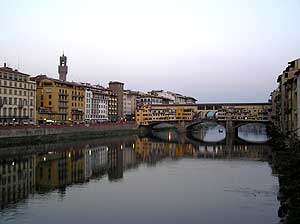 Occasionally,
if he aimed high enough or shot from far enough away, George could get a photo that looked like
one might expect Florence to look but, alas, that was not the reality we found ourselves in.
Admittedly we didn’t give ourselves a chance to enter the galleries and the museums and,
perhaps, that is a loss (to us) but what we love about Italy is not so much to be found in the
museums and the galleries as it is in the surroundings – in the being there. We enthusiastically
got on the train back to Prato having agreed to be on the road very early the next morning,
heading for somewhere (anywhere) that was small and up in the hills.
Occasionally,
if he aimed high enough or shot from far enough away, George could get a photo that looked like
one might expect Florence to look but, alas, that was not the reality we found ourselves in.
Admittedly we didn’t give ourselves a chance to enter the galleries and the museums and,
perhaps, that is a loss (to us) but what we love about Italy is not so much to be found in the
museums and the galleries as it is in the surroundings – in the being there. We enthusiastically
got on the train back to Prato having agreed to be on the road very early the next morning,
heading for somewhere (anywhere) that was small and up in the hills. 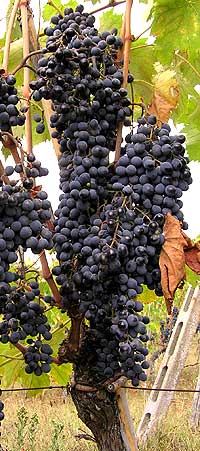
Later that day, we stopped in Volterra,
a hilltop town perched high on a rocky plateau. From a distance it had a forbidding air that
was quite a contrast to the gentle Tuscan countryside rolling out for miles at its foot. We
wound round and round the narrow road leading seeming endlessly, drove through one (we didn’t
know which) of the four stone gates of the medieval wall and stopped. We took a long walk through
(and beyond) the town to an active church retreat (Seminario di Sant’ Andrea,)described
in our Lonely  Planet
as a peaceful place with vaulted ceiling and 60 large, clean rooms open to all comers. It was
a lovely but hot (and dusty) walk and we arrived to discover that the retreat was closed for
renovations; they helped us find a hotel (Albergo Etruria) in the centre of town so we
walked back and reserved a room for two nights. From first sight, this town of about 12,000
people looked good to us – and we were in need of a rest.
Planet
as a peaceful place with vaulted ceiling and 60 large, clean rooms open to all comers. It was
a lovely but hot (and dusty) walk and we arrived to discover that the retreat was closed for
renovations; they helped us find a hotel (Albergo Etruria) in the centre of town so we
walked back and reserved a room for two nights. From first sight, this town of about 12,000
people looked good to us – and we were in need of a rest.
In Volterra, we ate lunch and dinner
that day and the next not only at the same wonderful restaurant: Il Porcellino  –
but at the same little outdoor table. The food was very much to our liking (wild game for George
and mushroom and vegetable, and cheese pastas for me) as was the local wine. It was harvest
time and the vineyards below were boastful, hanging heavy with lush grapes. The weather remained
sunny and warm so we wandered the streets, watching the skilled craftsmen carve the warm and
luminous (and colourful) local alabaster,
–
but at the same little outdoor table. The food was very much to our liking (wild game for George
and mushroom and vegetable, and cheese pastas for me) as was the local wine. It was harvest
time and the vineyards below were boastful, hanging heavy with lush grapes. The weather remained
sunny and warm so we wandered the streets, watching the skilled craftsmen carve the warm and
luminous (and colourful) local alabaster, 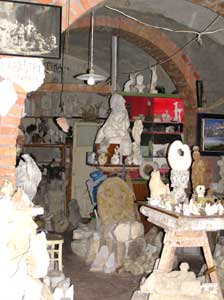 drawing
on secrets handed down from generation to generation, touring the ancient buildings and churches,
walking though all the city gates, and taking a nervous stroll along the perimeter of the fortezza
(fortress) commonly called the Maschio, from the name of the tower that looks over
the city. It was built in 1343 by the will of Duca d’Atene and later extended, between
1472 and 1475, by Lorenzo de’ Medici. A few years later (1478) it began to be used in
part as a prison, becoming a penitentiary with the Grand Duke decree in 1816, and now operating
as a maximum security prison. Situated as it is at the far end of a splendid town park (with
rolling green lawns and lush foliage), it is a disturbing and depressing sight. Noting the signs
that forbid approach and looking at the one massive gate leading into the place, we couldn’t
help but imaging the horror prisoners would feel arriving there; to escape down that cliff would
appear to be impossible…
drawing
on secrets handed down from generation to generation, touring the ancient buildings and churches,
walking though all the city gates, and taking a nervous stroll along the perimeter of the fortezza
(fortress) commonly called the Maschio, from the name of the tower that looks over
the city. It was built in 1343 by the will of Duca d’Atene and later extended, between
1472 and 1475, by Lorenzo de’ Medici. A few years later (1478) it began to be used in
part as a prison, becoming a penitentiary with the Grand Duke decree in 1816, and now operating
as a maximum security prison. Situated as it is at the far end of a splendid town park (with
rolling green lawns and lush foliage), it is a disturbing and depressing sight. Noting the signs
that forbid approach and looking at the one massive gate leading into the place, we couldn’t
help but imaging the horror prisoners would feel arriving there; to escape down that cliff would
appear to be impossible… 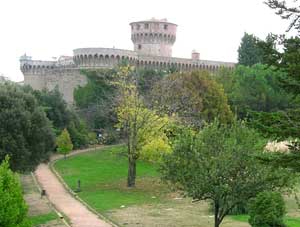 and
one could only cringe at thoughts of what life was like for the men residing in the windowless
cells of this ancient fortress. We turned and in a flash saw instead the lively, vibrant town
filled with colour, great food and happy people.
and
one could only cringe at thoughts of what life was like for the men residing in the windowless
cells of this ancient fortress. We turned and in a flash saw instead the lively, vibrant town
filled with colour, great food and happy people.
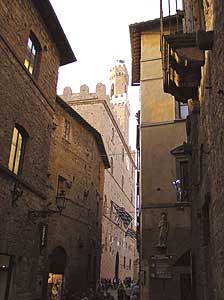
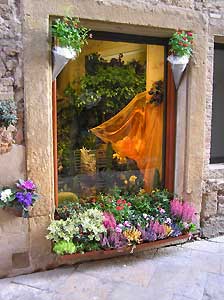
Volterra was indeed a fascinating place of dramatic contrasts; we left it almost as reluctantly as we had left Gubbio and we left only because we had agreed that, on this trip, we would begin to explore the South of Italy – another of those mistakes, perhaps, but only in retrospect.
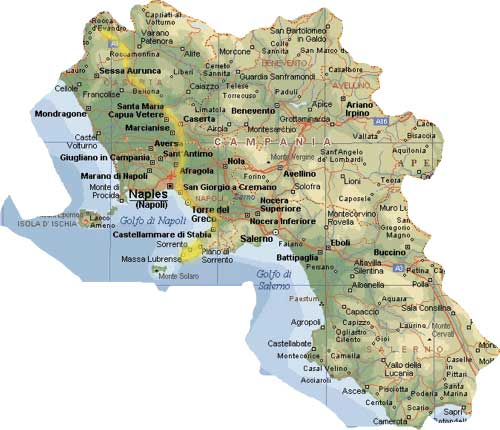
We drove all day, anxious to get to
the Amalfi Coast. It was getting dark as we were driving along the outskirts
of Naples – a scene of industrial sites and fumes, and dishevelled apartments –
not at all inviting. An hour or so later (and, by now, dark) we thought that we had almost reached
our destination but, as we continued to drive in the direction of Sorrento,
the traffic became progressively more congested; our arrival became a long, winding, seemingly
never-ending nightmare. When, finally, according to our map, we had arrived, we found ourselves
lost and still circling. Eventually George stopped the car and I made my way to Pensione
Linda which was described in our Lonely Planet as a budget hotel offering “a warm
welcome and old fashioned courtesy, as well as good value for money”. It was, in fact,
“a dump!” Parking the car proved to be a formidable challenge. We stayed the night.
We found a casual, pub-like, restaurant (the Red Lion) nearby that was popular with the hostel
crowd. Sitting at an outdoor table enjoying our food (particularly the deep fried zucchini flowers),
we agreed that the next morning we’d get up early and try to find a more acceptable abode.
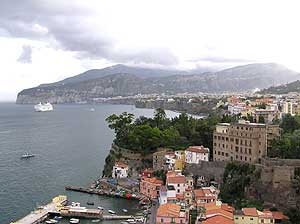 The next morning, walking along the road leading outside the centre of town, we found Hotel
Desiree. Overlooking the sea, this relaxed hotel (complete with a friendly cat and friendly
staff), was mid-range in price (about 90 Euros including parking) and they had one room vacant.
So we moved into our room (# 1) which had a balcony and a spectacular view of the Gulfs of Sorrento
and Naples and Mount Vesuvius in the distance.
The next morning, walking along the road leading outside the centre of town, we found Hotel
Desiree. Overlooking the sea, this relaxed hotel (complete with a friendly cat and friendly
staff), was mid-range in price (about 90 Euros including parking) and they had one room vacant.
So we moved into our room (# 1) which had a balcony and a spectacular view of the Gulfs of Sorrento
and Naples and Mount Vesuvius in the distance.  Feeling
more relaxed, we began to explore Sorrento. The sun had come out (it had been raining when we
arrived) so we walked back into the centre of town and down the path to the Marina Grande
(the old fish village) on the waterfront far below town. Sitting at a table on the pier,
we enjoyed lunch – especially memorable for George
Feeling
more relaxed, we began to explore Sorrento. The sun had come out (it had been raining when we
arrived) so we walked back into the centre of town and down the path to the Marina Grande
(the old fish village) on the waterfront far below town. Sitting at a table on the pier,
we enjoyed lunch – especially memorable for George 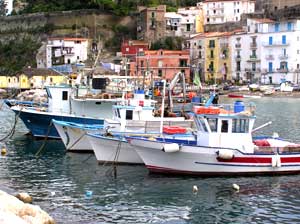 who
devoured his fresh sardines and photographed the skeletons. (He had shared the fish with a small
black cat who appeared beside our table from beneath the pier and who ate the sardines whole
- skeleton and all). The remainder of the afternoon we wandered the cobblestone streets,
who
devoured his fresh sardines and photographed the skeletons. (He had shared the fish with a small
black cat who appeared beside our table from beneath the pier and who ate the sardines whole
- skeleton and all). The remainder of the afternoon we wandered the cobblestone streets, 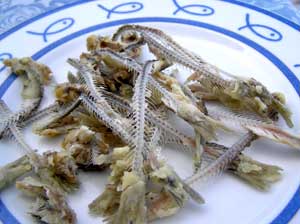 looked
into shops, tried to ignore the large infestation of tourists and kept remarking to each other
that most of them were Brits - by the end of our stay we were feeling a bit like we were in
England. (Sorrento, as we learned, is a popular travel destination with Brits, with many charter
and EasyJet flights arriving at the Naples airport and buses herding them into Sorrento
providing for their needs, hence the pubs and fish & chips). That evening we spent in restaurant
at the hotel next door that had a lovely dinning room; our table was by a window that looked
out to the sea. We watched a cruise ship sail slowly out of the port.
looked
into shops, tried to ignore the large infestation of tourists and kept remarking to each other
that most of them were Brits - by the end of our stay we were feeling a bit like we were in
England. (Sorrento, as we learned, is a popular travel destination with Brits, with many charter
and EasyJet flights arriving at the Naples airport and buses herding them into Sorrento
providing for their needs, hence the pubs and fish & chips). That evening we spent in restaurant
at the hotel next door that had a lovely dinning room; our table was by a window that looked
out to the sea. We watched a cruise ship sail slowly out of the port.
The next day started off with a drizzle
but, as we walked from our hotel into town, the skies cleared,so we took a ferry ride across
the bay to the fabled (and supposedly romantic)  Isle
of Capri where it was very hot, very crowded, filled with expensive shops and where
we sat down (thirsty, hot, and uninspired) in a crowded, hot restaurant and ordered a gorgonzola
pizza. As it turned out, this was our last meal on this trip to Italy. Somehow that pizza and
the whole touristy Isle of Capri scene turned us off food for the remainder of our stay. The
ferry rides over and back were pleasant; undeniably the setting is lovely. We looked up at our
little hotel perched high on a cliff and, on arrival at Sorrento, we bought a couple of apples
and some bottled water and headed back there to sit on our balcony. And that’s where we
stayed.
Isle
of Capri where it was very hot, very crowded, filled with expensive shops and where
we sat down (thirsty, hot, and uninspired) in a crowded, hot restaurant and ordered a gorgonzola
pizza. As it turned out, this was our last meal on this trip to Italy. Somehow that pizza and
the whole touristy Isle of Capri scene turned us off food for the remainder of our stay. The
ferry rides over and back were pleasant; undeniably the setting is lovely. We looked up at our
little hotel perched high on a cliff and, on arrival at Sorrento, we bought a couple of apples
and some bottled water and headed back there to sit on our balcony. And that’s where we
stayed.
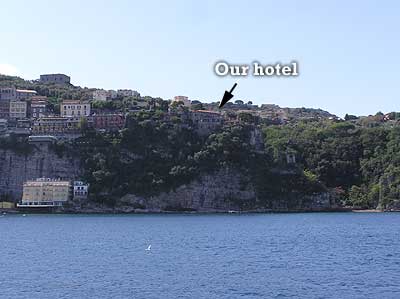
The next day we walked into the town centre, returning to a liquor shop that stocked Absinthe
and bought what we thought to be the most interesting bottle – Xenta Superior 140 proof,
70%volume, a brilliant green colour with a branch of Artemisia (the herb that flavours it and
that the smiling young clerk claimed was better than ‘ganga’ if you dried it out
and later smoked it) floating in it – that was our one purchase of the day – and
of this trip (aside from an alabaster ashtray from Voltera.)
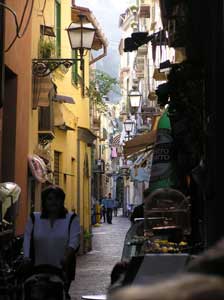
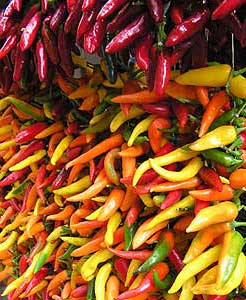
That afternoon we took a drive along the Amalfi Coast as far as Positano – a town described as postcard perfect and that is, while lovely for a postcard and from a distance, too trendy for us. A magnet for tourists, expensive boutiques lined every cobblestone alley. So, again, we scurried home to our balcony – this time to we watch a fantastic storm brewing over the water. Again we had no appetite so we crawled into bed early to experience, during the night, a truly spectacular thunder storm that, with lightening flashing from very close, providing quite a show.
Our final day was an early morning drive (not as terrible as the arrival) out of the area, and
to the airport for the flight home. We were very much ready to get back home and, only much
later, did we begin to think longingly of those restaurants that had not tempted us at all in
those final two nights in Italy.